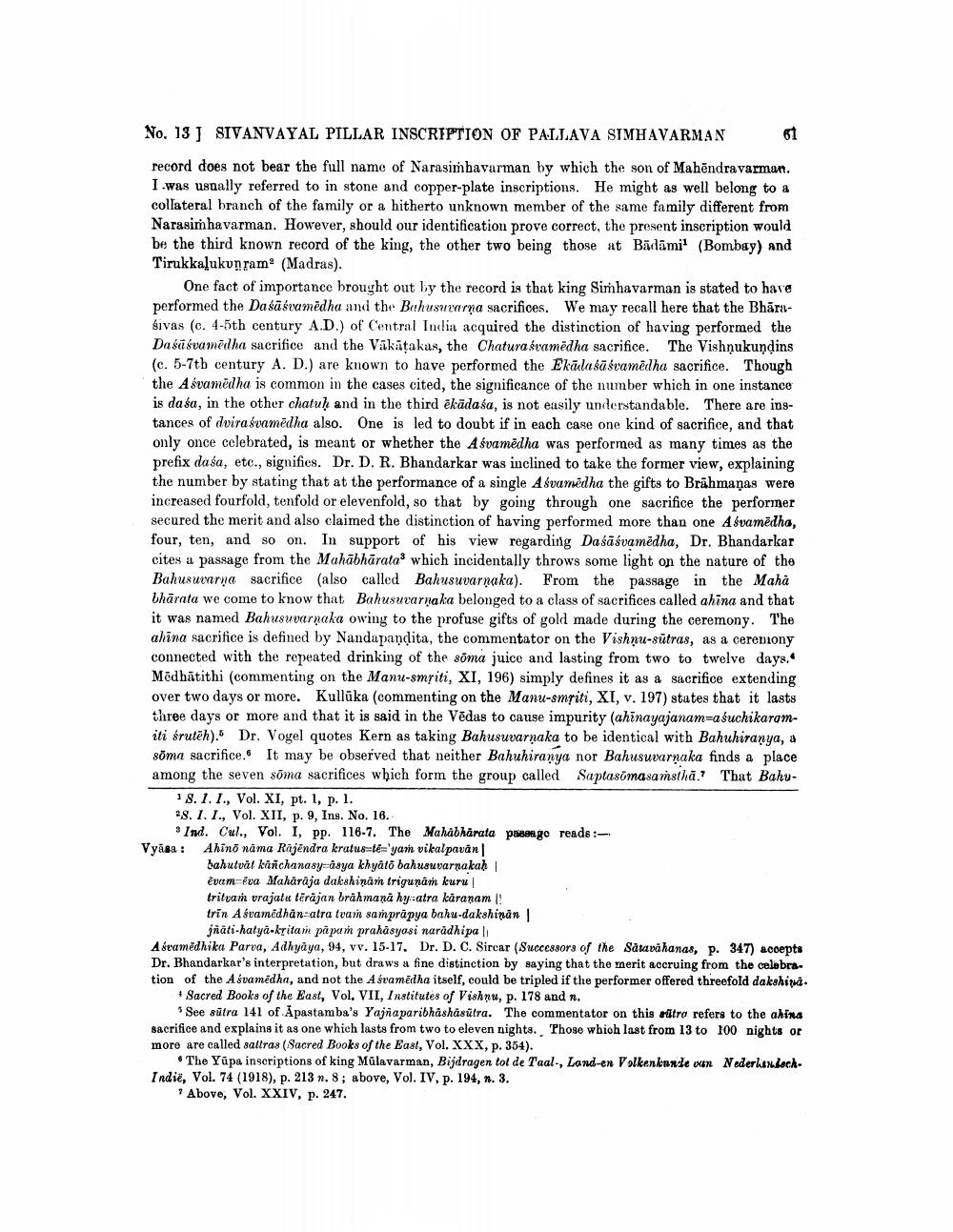________________
No. 13 ) SIVANVAYAL PILLAR INSCRIPTION OF PALLAVA SIMHAVARMAN
01
record does not bear the full name of Narasimhavarman by which the son of Mahöndravarman. I was usually referred to in stone and copper-plate inscriptions. He might as well belong to a collateral branch of the family or a hitherto unknown member of the same family different from Narasimhavarman. However, should our identification prove correct, the present inscription would be the third known record of the king, the other two being those at Badami (Bombay) and Tirukkalukun ramo (Madras).
One fact of importance brought out by the record is that king Simhavarman is stated to have performed the Daśāśvamēdha and the Bahusuwarna sacrifices. We may recall here that the Bhārasivas (c. 4-5th century A.D.) of Central India acquired the distinction of having performed the Dasüsvamēdha sacrifice and the Vikatakas, the Chatura suamëdha sacrifice. The Vishnukundins (c. 5-7th century A. D.) are known to have performed the Ekālasāśvamēdha sacrifice. Though the A évamedha is common in the cases cited, the significance of the number which in one instance is daśa, in the other chatuh and in the third ēkādasa, is not easily understandable. There are instances of dvira svamēdha also. One is led to doubt if in each case one kind of sacrifice, and that only once celebrated, is meant or whether the Aśvamëdha was performed as many times as the prefix daśa, etc., signifies. Dr. D. R. Bhandarkar was inclined to take the former view, explaining the number by stating that at the performance of a single Acvamēdha the gifts to Brāhmaṇas were increased fourfold, tenfold or elevenfold, so that by going through one sacrifice the performer secured the merit and also claimed the distinction of having performed more than one Afvamëdha, four, ten, and so on. In support of his view regarding Dasāsvamëdha, Dr. Bhandarkar cites a passage from the Mahābhāratas which incidentally throws some light on the nature of the Bahusuvarya sacrifice (also called Bahusuvarņaka). From the passage in the Maha Whārata we come to know that Bahusuvarnaka belonged to a class of sacrifices called ahina and that it was named Bahusuvarnaka owing to the profuse gifts of gold made during the ceremony. The ahina sacrifice is defined by Nandapandita, the commentator on the Vishnu-sütras, as a cerepiony connected with the repeated drinking of the sõna juice and lasting from two to twelve days. Mēdhätithi (commenting on the Manu-smriti, XI, 196) simply defines it as a sacrifice extending over two days or more. Kullūka (commenting on the Manu-smriti, XI, v. 197) states that it lasts three days or more and that it is said in the Vēdas to cause impurity (ahinayajanam-asuchikaramiti srutëh). Dr. Vogel quotes Kern as taking Bahusuvarnaka to be identical with Bahuhiranya, a söma sacrifice. It may be observed that neither Bahuhiranya nor Bahusuvarnaka finds a place among the seven söma sacrifices which form the group called Saptasömasamstha.? That Bahu
18.1. 1., Vol. XI, pt. 1, p. 1. 28. 1. I., Vol. XII, p. 9, Ins. No. 16.
Ind. Cul., Vol. I, pp. 116-7. The Mahabharata padenge reads :Vyasa : Ahino nama Rajendra kratuste='yan vikalpavan
bahutvål kanchanasyasya khyato bahusuvarnakah evam-Eva Mahārāja dakshinam triguņām kuru trituar vrajata tērajan brāhmanā hy-atra karanam ! trin Abramodhan-atra tvar samprapya bahu-dakshinan
jñati-hatya-kritam papam prahasyasi naràdhipali A śramëdhika Parva, Adhyâya, 94, vv. 15.17. Dr. D. C. Sircar (Successors of the Satavahanas, p. 347) accepts Dr. Bhandarkar's interpretation, but draws a fine distinction by saying that the merit accruing from the celebra. tion of the Asvamëdha, and not the Asvamēdha itself, could be tripled if the performer offered threefold dakshiwa.
Sacred Books of the East, Vol. VII, Institutes of Vishnu, p. 178 and n.
See sūtra 141 of Apastamba's Yajnaparibhashasūtra. The commentator on this sitro refers to the ahina sacrifice and explains it as one which lasts from two to eleven nights. Those whioh last from 13 to 100 nights or more are called sallras (Sacred Books of the East, Vol. XXX, p. 354).
• The Yüpa inscriptions of king Mülavarman, Bijdragen tot de Taal-, Land-en Volkenkunde van Nederler.lackIndië, Vol. 74 (1918), p. 213 n. 8; above, Vol. IV, p. 194, n. 3.
Above, Vol. XXIV, p. 247,




